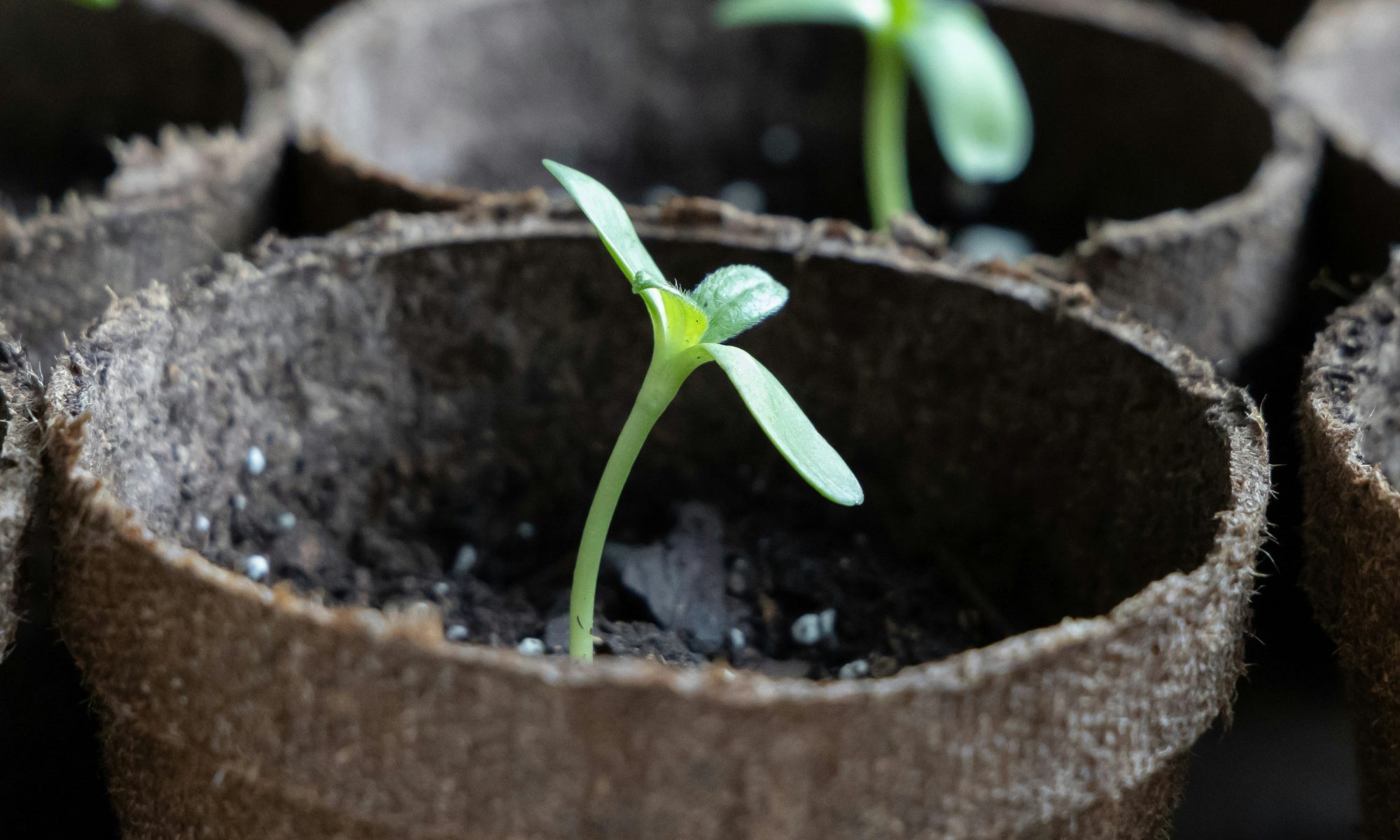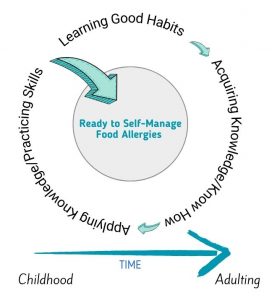One of our jobs as food allergy parents is to gradually hand off the responsibility for managing food allergies to our kids who have to live with them. Handing off the responsibility is like planting seeds, watering them, watching them sprout and grow, season by season. The seeds need nurturing along the way to bear fruit.
But they will bear fruit. In time.
The responsibility hand-off process starts slowly and gently in age appropriate ways and flows something like this:
Beginning at the Beginning
Forming good habits from an early age is the point of departure. Habits are a way the brain optimizes for efficiency and once habits are formed, they happen almost on autopilot — think brushing teeth, tying shoes, or looking both ways before crossing a street.
It’s not a huge step to make some aspects of allergic life habits, like wearing medical ID jewelry, carrying epinephrine everywhere, or bringing safe snacks every time you leave home. Forming these habits early in life will fit them seamlessly into daily life.
A Peek at the Future: Is Your FA Teen Ready for Launch?
I want to give you a peek at the future, not to overwhelm you, but to give you a true north to aim for as you help your child learn how to be responsible for their food allergies.
Thinking about your future self and your future teen, ask yourself a question: How will I know if my teen is ready to self-manage their food allergies? Without me?
Following are things to look for, to assess their readiness to self-manage.
And reality check: this ‘readiness assessment’ isn’t something you run through on the fly as you load the car for college move-in day. Instead, revisit it from time to time when they’re sophomores or juniors in high school, giving yourself plenty of lead time to address knowledge gaps and wobbly skills. I had an uh-oh parenting moment a few months before my son left for college. I discovered he wasn’t as solid on using his auto-injector or navigating a restaurant as I thought. Gaps happen!
What Teens Need to Know to ‘Own’ Their Food Allergies
THEIR DIAGNOSIS DETAILS…
Do they know all the foods they’re allergic to, where they’re commonly used in foods/cuisines, and tricky alt-names for their allergens? The key here is to have taught them the basics of their diagnosis, then how to apply it in their decision-making.
Mastering the Basics:
Some kids have long lists of food allergies, so it may be hard for them to keep track of all of them. My own son, when younger, struggled to keep track of his many allergens. So I get it. But when you send them off into the world, they will need to know each and every one of their allergens. Keeping a list of them in their phone’s Notes app could help.
Being Able to Apply the Knowledge:
Knowing where their allergens can hide in different foods is important. My son learned the hard way that all pizza crusts are not created equal. Some are made with egg. Others are not. This tough lesson made him more diligent about asking detailed questions about menu items (ingredients and preparation methods) at restaurants.
For label reading, knowing alternative names for their allergens is important, too. Did you know that ‘Casein’ and ‘Rennet’ are Dairy and ‘Natto’ is Soy? This summary from Allergic Living of foods — where top allergens hide and alt-names for allergens — is a good place to start.
HOW TO USE THEIR EPINEPHRINE…
Patients now have more epinephrine options than ever before, including a needle free nasal spray called neffy. The FDA will review another needle-free epinephrine option (Anaphylm) in early 2026 — a postage stamp-sized film you place under the tongue that dissolves without water. Imagine having two needle-free options to choose from! This could be life changing for some families.
Teach your kids how to use their epinephrine, whatever you’ve been prescribed. For example, when small, let your kids use their trainer on a beloved teddy bear, or hand-off training the babysitter or a coach to older kids. Start practicing this early and often.
Teach your kids to go everywhere with their epinephrine and emergency action plan, keeping them within arms reach. All. The. Time. Model it for them in the early years; hand off the responsibility gradually as they demonstrate they can manage and keep track of their belongings.
Your teen needs to know how to care for their epinephrine, too (like not leaving it in the car or taking it swimming), and they should know how to check and track their device’s expiration dates so they know when they need a prescription refill.
HOW TO MANAGE AN ALLERGIC REACTION…
It’s important for teens to know the telltale signs of an allergic reaction, whether they remember experiencing one or not.
This Overview of Anaphylaxis from the American College of Allergy, Asthma & Immunology is a good one to share.
Your teen needs to know:
- The difference between mild and severe symptoms.
- To take any symptoms seriously, even if they’ve never had a serious reaction before, since previous allergic reactions don’t predict the severity of future reactions.
- Asthma and co-factors like exercise, infection, NSAIDs (like Advil and Motrin), dehydration, and alcohol can influence their sensitivity to allergens and reaction severity.
- When two body systems are involved (e.g., vomiting and hives, swelling and nausea) a reaction is considered severe and requires epinephrine.
- Epi first. Epi fast. — even if they question a reaction’s severity and the need.
- Why they should carry TWO doses of epinephrine. (Yes! There’s a reason epinephrine is sold in ‘TWO Packs’! ) and when to use the second dose.
- Antihistamines will not stop an anaphylactic reaction.
- To ask for help. Not go it alone.
Epinephrine is the only thing that can stop anaphylaxis and there’s no harm in using it. The benefits of administering epinephrine far outweigh the risks.
HOW TO READ FOOD LABELS…
Reading food labels should be a habit for your teen. At a minimum, if your teen hasn’t read the food label, they shouldn’t eat the food.
But here’s the thing about food labels — the ‘May Contain’, ‘Made on shared lines’, ‘Made in the same facility’ statements are 100% voluntary disclosures. They’re not regulated by the FDA other than guidance that they must be truthful and not misleading.
And that’s when manufacturers CHOOSE to use them.
When you don’t see those statements, their absence doesn’t mean the food is free of allergens. It doesn’t mean the food product is any safer to eat than foods with the disclosures. The only way to determine if a food may contain your allergens is to call the manufacturer and ask detailed questions.
Your teen needs to know:
- What your family’s decision rules are regarding precautionary allergen labeling like ‘May Contain’, ‘Made on shared lines’, ‘Made in the same facility’ and how to apply the rules to a buy/don’t buy decision.
- Even if it’s a trusted brand they’ve eaten safely before, formulations can change. This means they need to reread the label every time they want to buy the product.
- To be wary of mini-versions of candies and snacks. Sometimes these are produced on different lines or in different facilities. Never assume they’re exactly the same as the larger versions.
- To look for foods with free from certifications like the ‘Certified Free From Allergens‘ certification that’s appearing on more and more food products.
- Reading an ingredient label backwards and forwards can help them spot allergens, especially when they have non-top 9 allergens.
- And in a perfect world, when to call a food manufacturer and what questions to ask the manufacturer. This is an important allergic life skill but a big ask of teens/young adults with on-the-go lives.
HOW TO SELF-ADVOCATE…FEARLESSLY…
Speaking up on your own behalf can be harder for some than others, whether you’re a child, a teen, or an adult. But, self-advocacy is a critical skill for people with food allergies. It takes courage, confidence.
Your teen’s allergy-risk radar needs to be constantly scanning surroundings for allergy risks and they will need to be able to proactively speak-up to protect themselves.
Your teen needs to know:.
- How to succinctly explain their food allergies and cross contact to restaurant staff, baristas, coaches, teachers, friends, RA’s, roommates, sorority sisters & fraternity brothers, etc. and observe closely for the lights to go on. Or, not.
- Red flags to look for that can help them evaluate a situation’s riskiness and know what to do.
- And always, to ask for help, sooner rather than later, if a reaction is brewing.
HOW TO SOCIALIZE SAFELY…
From restaurant outings to parties to team dinners to classroom & club activities to awards banquets, socializing is often food and drink centric.
Having go-to strategies, planning ahead for the unexpected, can help. Help them devise strategies and practice them in high school, before they’re flying solo, like:
- Eating before venturing out.
- Packing a boatload of safe snacks to go with.
- Taking a pass on drinking or at least not sharing drinks.*
- Drinking out of bottles vs. glasses.*
- Avoiding punch concoctions with ‘who knows what’ ingredients.*
- Having an ‘out’, even if fabricated, for a graceful, early-ish exit.
- Even learning how to call an event organizer or host before an event to figure out food and drink plans.
Learn more about the risks of alcohol — from drinks that contain allergens, to clouding judgement, to being a co-factor that can lower reaction thresholds — and consider sharing this article with your teen/young adult when the moment is right.
(*I do not mean to disrespect family values with these points, but kids might be tempted to experiment with alcohol in high school, as well as in college, so they need to be aware of risks and workarounds to protect themselves. Peer pressure can be fierce and hard to withstand at times.)

As a food allergy parent you always want to be in food allergy hand-off mode with your child, with one eye on today, and one eye on the future.
Go slowly. Patiently. Relentlessly. Over the years. As they grow.
You can download a tool here to help you check your teen’s readiness to self-manage their food allergies. Bookmark this tool and use it for speed and heading checks from time to time, especially when your teen is in high school.
“The greatest gifts you can give your children are the roots of responsibility and the wings of independence.”
—Denis Waitley, motivational speaker and writer
 |
Empowering people to live more easily & safely with food allergies through technology and education. |
| About the Author: Gayle Rigione is CEO of Allergy Force, the food allergy management app. She’s also an allergy mom. She’s lived the heart stopping moments when her son ate the wrong thing, second guessed reactions and raced to the ER. Her professional and personal experiences fuel her passion for creating tools for people with food allergies. Whatever you do, do it with a full heart. Audentes Fortuna Iuvat | |
Images: Courtesy of Allergy Force and Rachel Reinhardt on Unsplash
Resources
Forming Good Habits
- TedxFremont talk by BJ Fogg: “Forget big change, start with a tiny habit”
- Article by Elizabeth Dougherty (McGovern Institute for Brain Research) for MIT News: Wired for habit
- Article by Elizabeth Perry, ACC for www.betterup.com: Building good habits in your life (and ditching bad ones)
- Article by James Clear—Bestselling Author, Speaker: How To Start New Habits That Actually Stick
- Article by James Clear: How to Build a New Habit: This is Your Strategy Guide
- Post by Seth Godin—Bestselling Author, Entrepreneur, Speaker: Make a habit/break a habit



